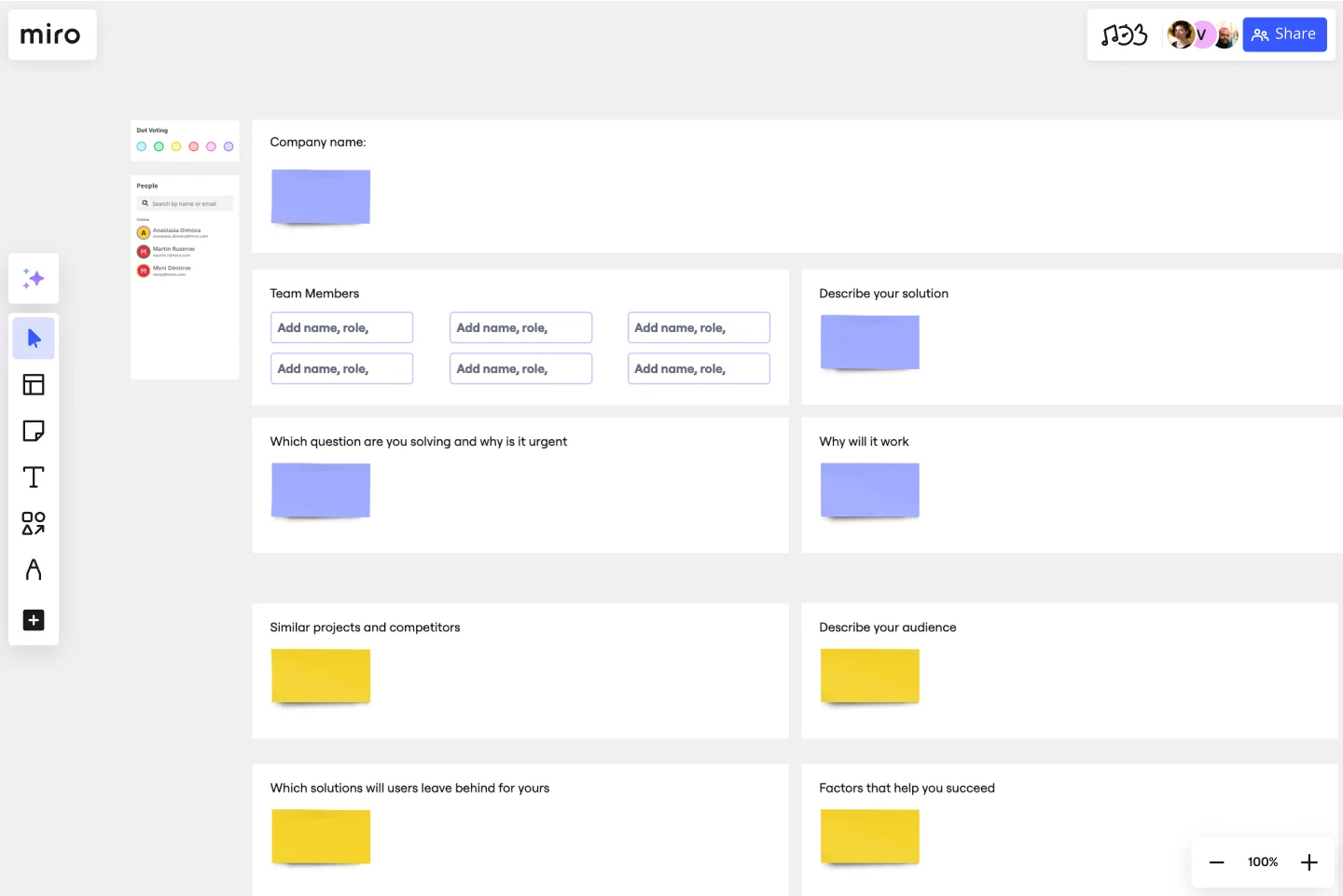Startup Canvas Template
Use this Idea Canvas Template as a useful visual map for founders who want to judge their new business idea's strengths and weaknesses. Share all your important start-up activities and information on just one single page.
About the Startup Canvas Template
Startup canvases are a useful visual map for founders who want to judge their new business idea’s strengths and weaknesses.
By articulating factors like success, viability, vision, and value to the customer, founders can make a concise case for why a new product or service should exist and get funded.
Need a canvas that helps you map out the profitability of your startup idea? That sounds like a Lean Canvas. If you have an existing business model you’d like to visualize, try out the Business Model Canvas.
What is a startup canvas?
A startup canvas helps founders express and map out a new business idea in a less formal format than a traditional business plan.
This canvas can be used as a framework to quickly articulate your business idea’s value proposition, problem, solution, market, team, marketing channels, customer segment, external risks, and key performance indicators.
Create your own startup canvas
Get started by selecting the startup canvas template, then take the following steps to make one of your own:
1. Name your business and confirm your team
Even if you haven’t registered a business name yet, the company name segment can be a space to brainstorm what you’ll call your new venture. Assemble the name of your dream team and on the details with you too.
2. Fill in each customer-related segment
From what your company stands for to your vision, values, each piece will help clarify your idea. Use each “statement” to start drafting key points based on understanding your customer’s key problems – and how your business idea offers a genuine solution.
3. Add at least two to three points for each customer-related segment
Each segment can contain at least three relevant ideas. For example, what are three market research insights or statistics that prove your business idea’s viability?
4. Check the confidence of your language
A startup canvas helps you turn broad ideas into a research-backed concept. Use clear, concise language instead of hedging statements (such as “but” or “however”). Your goal is to turn unaware investors into engaged business prospects.
5. Share the canvas with your team
After you’ve filled in all the segments, share the filled-in startup canvas template with team members or potential investors to get feedback and keep refining your business idea.
Get started with this template right now.
Agile Board Template
Works best for:
Agile Methodology, Meetings, Agile Workflows
Part of the popular Agile framework, an Agile Board is a visual display that allows you to sync on tasks throughout a production cycle. The Agile Board is typically used in the context of Agile development methods like Kanban and Scrum, but anyone can adopt the tool. Used by software developers and project managers, the Agile Board helps manage workload in a flexible, transparent and iterative way. The Agile template provides an easy way to get started with a premade layout of sticky notes customizable for your tasks and team.
Spider Diagram Template
Works best for:
Diagramming, Mapping
Perfect for brainstorming sessions, project planning, or simply organizing thoughts, the Spider Diagram Template allows you to create 'legs' branching out from a central idea, representing related topics or subtopics.
Thematic Roadmapping (Vision & Strategy)
Works best for:
Roadmap, Planning, Mapping
The Thematic Roadmapping (Vision & Strategy) template empowers organizations to align their vision with actionable strategies. By identifying key themes and strategic objectives, teams can develop a roadmap that guides decision-making and resource allocation. This template facilitates cross-functional collaboration and ensures that initiatives are aligned with overarching goals, leading to more focused and impactful execution.
Presentation Template
Works best for:
Presentations, Education
At some point during your career, you’ll probably have to give a presentation. Presentations typically involve speaking alongside an accompanying slide deck that contains visuals, texts, and graphics to illustrate your topic. Take the stress out of presentation planning by using this presentation template to easily create effective, visually appealing slides. The presentation template can take the pressure off by helping your audience stay focused and engaged. Using simple tools, customize a slide deck, share slides with your team, get feedback, and collaborate.
Self-Evaluation Template
Works best for:
Organizational Design
The Self-Evaluation Template is a structured tool that helps people reflect on their professional performance. It offers a comprehensive framework to assess all key areas of contributions and interactions within an organization. The template has the significant benefit of fostering enhanced self-awareness by systematically reviewing each section. Professionals gain deeper insights into their work behaviors, strengths, and areas for improvement. This heightened self-awareness not only helps in personal growth but also equips people to engage more productively in feedback discussions with their supervisors and peers.
Resource Management Gantt Chart
Works best for:
Strategy, Planning
Efficient resource allocation is crucial for project success. The Resource Management Gantt Chart template helps you plan and manage your resources effectively. Use it to track the availability and allocation of personnel, equipment, and materials throughout your project. This template ensures resources are optimally utilized, reducing waste and avoiding delays, providing a clear overview of assignments and workload balance.
